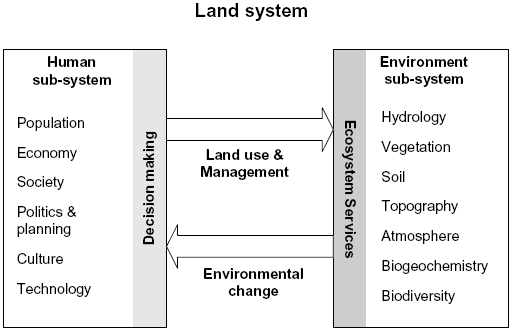2 Conceptual model of land systems
The relation between human land-use activities and environmental change can be described as a coupled human-environment system with socio-economic as well as ecological and biophysical components as sub-systems (Mather, 2006). These “land systems” form the terrestrial part of the Earth System and therefore are critical components of global biogeochemical cycles and energy fluxes (GLP, 2005*). For example, agriculture is influenced by weather and climate and in turn affects climate by energy and water fluxes and the release of greenhouse gases such as carbon dioxide and nitrous oxide. Figure 1* shows the components of a “land system” and their linkages as defined within the Science Plan of the Global Land Project (GLP, 2005*, p. 8, Fig. 4).In order to describe the functioning of the human sub-system, we build upon Geist and Lambin (2002*) who introduce a two level hierarchy of proximate and underlying causes (or drivers) for explaining tropical deforestation. Proximate causes are human land-use activities at the local level (e.g. agricultural expansion and infrastructure extension) while underlying causes are fundamental societal processes that underpin the proximate causes and either operate on the local level or are influenced by processes on the national or global level. They include demographic, macro-economic, technological, policy and cultural factors.
According to this approach, the level of proximate drivers of the human sub-system covers processes of human decision making that directly lead to land-use changes at a certain location. In contrast, the level of underlying drivers of the human sub-system is used to describe dynamics at a larger scale level (region, country, globe) that have an effect on the local decision making process. For example, prices for agricultural commodities can be described as the result of international economic markets and policies on the underlying level but have a direct affect on management decisions of farmers on the local level.
The environment sub-system is characterized by the complex interplay between a-biotic and biotic factors and processes within natural and managed ecosystems (e.g. hydrology, soil, vegetation, biodiversity) that provide goods and services to the human sub-system, such as crop yields, clean air and potable water (GLP, 2005).
The human and the environment sub-systems are closely linked. Human land-use and management activities can lead to changes in the functioning of ecosystem processes and consequently to its ability to provide the aforementioned goods and services. This environmental change in turn can affect the human sub-system both on the underlying and proximate level. An example for such feedback mechanisms is non-sustainable agricultural management that leads to soil degradation, for example in form of erosion or soil nutrient depletion. The resulting soil degradation causes a decrease of the ecosystem service “crop yield” (environmental change) which in turn forces the farmer either to adapt his agricultural management practice or sooner or later to abandon his land. These links between system components, or in other words feedback mechanisms and their representation in integrated models, are one of the foci of this paper.





